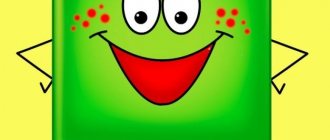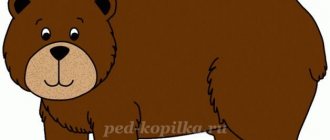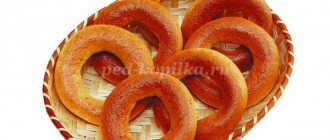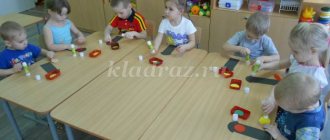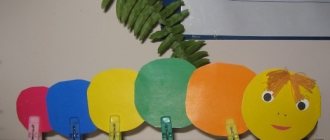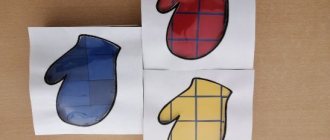Lesson summary - entertainment in mathematics in the second junior group
Lesson summary - entertainment in mathematics on the topic: “Journey to the Fairytale Forest.” Junior group
Developed and conducted by the teacher of the MB preschool kindergarten No. 199 Sipratova Klavdiya Viktorovna, Ulyanovsk.
Description of the material: I offer you a summary of a fun lesson in mathematics for children of the second junior group (3-4 years old) on the topic: “Journey to a fairy-tale forest.” This material will be useful to teachers of the second younger group, as well as parents who have children 3-4 years old. This material is presented in a playful form and is aimed at generalizing and consolidating knowledge about geometric shapes, the ability to compare objects by length and width, and establish equalities and inequalities between two groups of objects. Integration of educational areas: “Cognition”, “Communication”, “Socialization”, “Artistic and Aesthetic”. Program content: 1) train children in the ability to distinguish geometric shapes: circle, square, triangle. Reinforce the concepts of “one”, “many”; 2) consolidate children’s ability to compare objects in length and width, denoting the result with the words “longer-shorter”, “wider-narrower”, “equal in width”, “equal in length”; 3) consolidate the ability to establish equalities and inequalities between two groups of objects located in a row, to use the expressions “more”, “less”, “equally”; 4) cultivate in children the ability to listen to the teacher, to act on the teacher’s signal; friendships between peers. Previous work: children practiced distinguishing shapes; played the game “Find the same one”; learned to compare objects by length and width, denoting the result in words; practiced the ability to establish equalities and inequalities between two groups of objects. Equipment: demonstration material: tambourine, three hoops, circle, square and triangle;
two large toys - a bear and a bunny; two strips of the same length, but different widths. handout: for each child, geometric shapes - circles, squares, triangles; strips - 2 for each child of the same length, but different widths; a flower cut out of paper (for each child). Progress:
I seat the children at the tables and say: “Guys, today we will go on a journey through the Fairytale Forest.
And we will go to the forest by train (I show the children the train, which is built from chairs). Take all your seats, sit down comfortably. We went with you to the Fairytale Forest (the song “Train” by music by Metlov is playing). Guys, here we are and we have arrived in the Fairytale Forest. The clearing we are in is called “Find Your House”. Now I will distribute geometric figures to you all, and you tell me what geometric figures I gave to you (I ask 6-7 children). Well done, these are circles, squares and triangles - these are geometric shapes. All these figures live in houses, here they are (pointing to the hoops lying on the floor). Now you will all run around the clearing, and when I hit the tambourine, each of you will have to find your own house. Whoever has a circle runs to the house where the circles live, who has the squares - to the house where the squares live, and who has the triangles - to the house where the triangles live (after which the game begins, when the children have found their house, I clarify: “Guys , (pointing to the children who are standing in the house where the circles live), what kind of figure do you have? (that’s right, a circle). Sasha, how many circles do you have? (one) (I ask 2-3 children). That’s right, you have each one circle. And how many circles are there in a hoop? That's right, a lot. (I ask 2-3 children). (The game is repeated several times; when repeated, you can swap the hoops or the figures lying inside.) Well done, kids, they were able to find their house and don't make a mistake. Now get on the train, we'll go with you to another clearing (the song "Train" by Metlov's music sounds). We've arrived. Look, there's a bear and a bunny sitting there, they're crying. Let's go up to them. Why are you crying, little teddy bear and little bunny? ? Guys, they say that they can’t find which path is narrow and which is wide. If they follow the narrow path, they will wander into the Dense Forest, and if along the wide path, then to the Fun Squirrel. Help them find where the path is narrow and where the path is wide (I hand out strips to the children). Guys, first show me the length of each track (they show), and now the width (they show). Guys, what are the length of the tracks? (I ask 3-4 children). That's right, they are equal in length. How wide are the tracks? (3-4 answers) (narrow and wide). How do you know which path is narrower and which is wider? What do I need to do? That's right, put the strips on top of each other. Put them on (children compare the stripes and determine what they are). Okay, well done! Guys, tell us how you compared and what happened? (2-3 answers). So which strip is wide and which is narrow? (2-3 answers). Right. The white stripe is wide, and the green stripe is narrow. If a bunny and a bear walk along the green path, where will they wander? (to the Deep Forest). And if - along the white carpet? (to the cheerful squirrel). So, bear and bunny, walk along the wide white path and it will lead you to the cheerful squirrel. Well, the guys and I will go to another clearing. Guys, get on the train and let’s go (the song “Train” by Metlov is playing). Guys, we have arrived at the clearing. Take a rest. Physical education minute. Now music will play here, and you will dance (I turn on the music - the children dance). Guys, look how many flowers have grown in the clearing! How many are there? (a lot of). Let's play the game "Butterflies and Flowers" with you. You are all turning into butterflies. Sasha is a butterfly, Seva is a butterfly, Katya is a butterfly. How many butterflies do we have? (a lot of). The butterflies have flown! (children wave their “wings” - their arms and run around the clearing. At the signal: “Butterflies!” - the children sit down, i.e. stand near their flower). Guys, look, there is a butterfly on this flower, a butterfly on this flower, and a butterfly on this one too. What are more (less) flowers or butterflies? That's right, they are equal! There are as many flowers as there are butterflies, and there are as many butterflies as there are flowers. The butterflies rested and flew again (the game is repeated 2-3 times). Well done boys! Today we had a good trip through the Fairytale Forest. And now it’s time for us to go to the group (the children get on the “train” and, to the music, we go to the group). Here we are. Let's remember where we were today, what we did, who did we help? (I’m summing up the fun activities with the children). Well done boys! Our journey to the Fairytale Forest is over, you can go and play.”
We recommend watching:
GCD on FEMP in the second junior group Summary of organized educational activities on FEMP in the second junior group Synopsis of a frontal lesson on FEMP in the 2nd junior group GCD in mathematics in the 2nd junior group
Similar articles:
Math lesson notes. Theme: “One - many, big - small.” Second junior group
Math lesson notes. Topic: "Circle". Second junior group
Summary of a lesson on FEMP in kindergarten in the second junior group. Topic: “Spatial relations”
Summary of a lesson on FEMP in kindergarten in the second junior group. Triangles
Summary of lessons in kindergarten in the younger group. Topic: “Parts of the day”
Mathematical entertainment in the second junior group
Mathematical entertainment in kindergarten in the second junior group “Journey to the country of Mathematics”
Description of the material: I offer you a summary of an entertainment lesson in mathematics for children of the second junior group (3-4 years) on the topic: “Journey to the country of Mathematics.” This material will be useful to teachers of the second younger group, as well as parents who have children 3-4 years old. This material is presented in a playful form and is aimed at generalizing and consolidating knowledge about geometric shapes, the ability to compare objects by length and width, and establish equalities and inequalities between two groups of objects. Integration of educational areas: “Cognition”, “Communication”, “Socialization”, “Artistic and Aesthetic”. Program content: Form elementary mathematical concepts. Continue to introduce children to time concepts: morning, day, evening, night, exercise children in the ability to distinguish geometric shapes: circle, square, triangle. To consolidate the concepts of “one”, “many”; to consolidate the ability of children to compare objects in length and width, denoting the result with the words “longer-shorter”, “wider-narrower”, “equal in width”, “equal in length”; to consolidate the ability to establish equality and inequality between two groups of objects arranged in a row, use the expressions “more”, “less”, “equally”; fix the main colors. Develop visual and auditory perception; develop visual-figurative thinking; develop imagination, the ability to navigate in space, ingenuity, and ingenuity. Develop an interest in joint activities with adults and peers. Cultivate interest in mathematics; the ability to listen and hear the teacher, act according to the verbal instructions of an adult; cultivate responsiveness and a desire to help others. Methods and techniques: Verbal – questions, reminders, encouragement.
Visual – demonstration of maps, images of heroes. Game - riddles. Practical - actions with didactic material. PROGRESS
Guys, tell me, did you all say hello to each other this morning? Let's greet each other again, just not with words, but with our noses (shoulders, tummies). Let's hold hands and make a small circle. Raise your palms up and let's say hello to the sun, feel its warmth and give this warmth to each other and our guests (close your palms and blow on them).
Surprise moment “A balloon and an envelope on a string” (unusual envelope, figured, colored) I wonder who it’s from? And in the envelope is an invitation from the Queen of Mathematics to visit her.
Guys, shall we accept her invitation? Why do we need mathematics? What does she teach us? (children read)
- She teaches us to count and recognize shapes, to know where is left and where is right, to know the length and width! — Mathematics is precise, mathematics is necessary, children love to count everything, you just need to understand. Well, since we need mathematics so much, then we accept her invitation and go to visit her. I know the magic words that will help us go to a magical land. “We’ll stamp our feet, clap our hands, turn around, hold hands together, close our eyes, say “Ah” and find ourselves a guest. Look how unusual it is in a fairyland, what kind of trees are in the forest? (high and low) leaves on trees are not ordinary, but what kind? (curly, multi-colored, carved)
(B. Yaga appears from behind the tree) B. Yaga: Hello kids, Skodas, yes rogues, capricious, lazy, you are all my favorites. I am the Queen of Mathematics! Did you bring me any gifts, or treats, or at least a small cookie? Educator: Guys, it seems to me that our guest does not look like the Queen of Mathematics. B. Yaga : How different? Here I have a crown and numbers, I am a real Queen! Educator: Guys, let's check if this is the real Queen of Mathematics and ask her riddles. — The sun is high in the sky and far from night, the trees are in short shadow, what time of day is it? (day) - The bright sun is rising, the cockerel is singing in the garden, our children are waking up, getting ready for kindergarten (morning) - The radiant sun has set behind the house, we have come from a walk, is it time for dinner? (evening) - The stars are shining in the sky, the streams are talking in the river, the moon is looking through our window, telling our children to sleep (night) (Baba Yaga gets confused, the children correct her) Educator: Why, Baba Yaga, haven’t guessed a single riddle, you're probably not real. B. Yaga: If I’m not real, I’m the most unreal, Queen Mathematics, you’re the one who’s asking the wrong riddles. Now I will test you and turn you into butterflies, you will need to follow a signal, find your flower and be careful, I like to confuse children like you. Let's stand in a circle and say the magic words: “The magic is about to begin, all you have to do is put on your hats, turn to the right and clap, turn to the left and stamp, we all smile and turn into butterflies” (to the music the children fly and each one finds their own flower by color)
(teacher questions: What kind of butterfly are you? I am a red butterfly and sat on a red flower, etc.) How many butterflies? How many flowers? (number of butterflies and flowers, equally or more flowers than butterflies) - I remove one flower, trying to confuse the guys. B. Yaga : Oh, your head is about to explode, turn around and turn into children. Educator : You see, Queen Mathematics, you are wrong, our children are smart and coped with your task. B. Yaga: Oh little breeze, my friend, hurry up and drive the cloud here, let the rain of children water the Muses. game song “Rain” (showing movements)
B. Yaga: Okay, I give up and confess to you. I really am Baba Yaga, and I hid your queen in a house and mixed up the paths to this house, confused you, you won’t find the way to her. And I’m running away from you, I have to go, goodbye kids! Educator: Guys, Baba Yaga ran away, but did not remove her witchcraft, the wind scattered all the rays of the sun on the ground, let's help collect all the rays of the sun. (Anya, where did you find the ray? (behind a stump, on a tree, under a bush, etc.)
Guys, look, are all the rays of the sun the same? (long and short, wide and narrow) How do we determine? (we need to put one ray on top of another and then we’ll find out. So the sun has shone and illuminated our path, let’s move on. And on the way we have two paths, one long and the other short, what do you guys think, which path will we take the fastest? ( (short version) They come to the house of the Queen of Mathematics. (Locks are depicted on a magnetic board, you need to pick up a key for each lock, and the key is not simple, it’s shaped and colored) Game: “Pick up a key to your lock.”
Queen Mathematics comes out, thanks the children and gives them a didactic board game “The Cunning Artist”
We recommend watching:
Summary of GCD in mathematics in the younger group. The use of non-traditional forms of work in mathematics GCD for children of the junior group in mathematics “Bigger, smaller, smallest” Summary of a lesson in mathematics 2nd junior group “Geometric figures” Summary of a lesson on FEMP in the 2nd junior group. Journey to Geometry
Similar articles:
Math fun for the younger group of kindergarten
Summary of a mathematical game in the second junior group
Summary of the game in mathematics in the younger group
Mathematics lesson in the younger group “Parts of the day”
Summary of the lesson in mathematics “Number and figure 2”. Junior group
FEMP entertainment in the 2nd junior group “Visiting the Clown”
(The clown takes pre-prepared jars of clean water, with a drop of paint on the lid, and shakes them vigorously. After the water is colored, the clown asks the children what happened to the water, what color it turned into).
K: Well, what did you like? Want to see more?
D/I “Compare the object”
Goal: to consolidate children’s knowledge about geometric shapes, to develop the ability to correlate various objects with geometric shapes.
K: Guys, look at my hat (say the color of the hat), there’s nothing there. Watch what happens now.
-Hocus, pocus, carabous!!!
(The clown takes turns taking a plate, a pyramid, a box out of his hat. Each time, asking the children what he took out and what geometric figure the object resembles, calling one child, who must match it with the figure on the flannelgraph).
K: Oh, but the box is not empty, there is something in it, what’s there? (children’s answers, there are geometric shapes according to the number of children, he distributes them to the children and asks which figure, praises the children)
K: Guys, I know a game with these geometric shapes. Shall we play?
Conducts the game “Find your house”
(There are 3 hoops on the floor, in which there are large figures - a circle, a square, a triangle, children must match their figures with the large ones. At the end of the game, an analysis is made of how many figures are in the hoop. Goal: to consolidate the concept of one - many.)
Q: Lyapa, why are you always alone at the circus? Don't you have any help?
K: Oh, I completely forgot. I have just wonderful trained kittens (brings in a basket of kittens).
He takes out pictures of kittens and attaches them to the easel. Let's count the kittens (one, two, three, four). My kittens love to play with balls, but the trouble is, all the balls are mixed up. Let's get each kitten its own ball.
Children find distinctive features and select their own ball for each kitten, explaining their choice (the color of the ball matches the color of the kitten’s bow, but 1 kitten is missing a ball, the clown leads to the fact that there are more kittens than balls).
K: Oh, one kitten didn’t have enough ball, why? (children's answers)
Q: Thank you, Lyapa, you have wonderful kittens!
K: And as a farewell, I’ll show you one more trick. I also know colors and can guess them with my eyes closed, would you like to see?
(the teacher blindfolds the clown, shows apples of different colors and asks questions)
Q: What color is this apple? (red)
Q: I would like to know what color this apple is? (yellow)
Q: Do you know what color this apple is? (green)
Q: Lyapa, you showed us wonderful tricks, and we want to please you. Guys, do you agree? (children go to tables where there are cards with pictures of large and small balloons and colored pencils).
